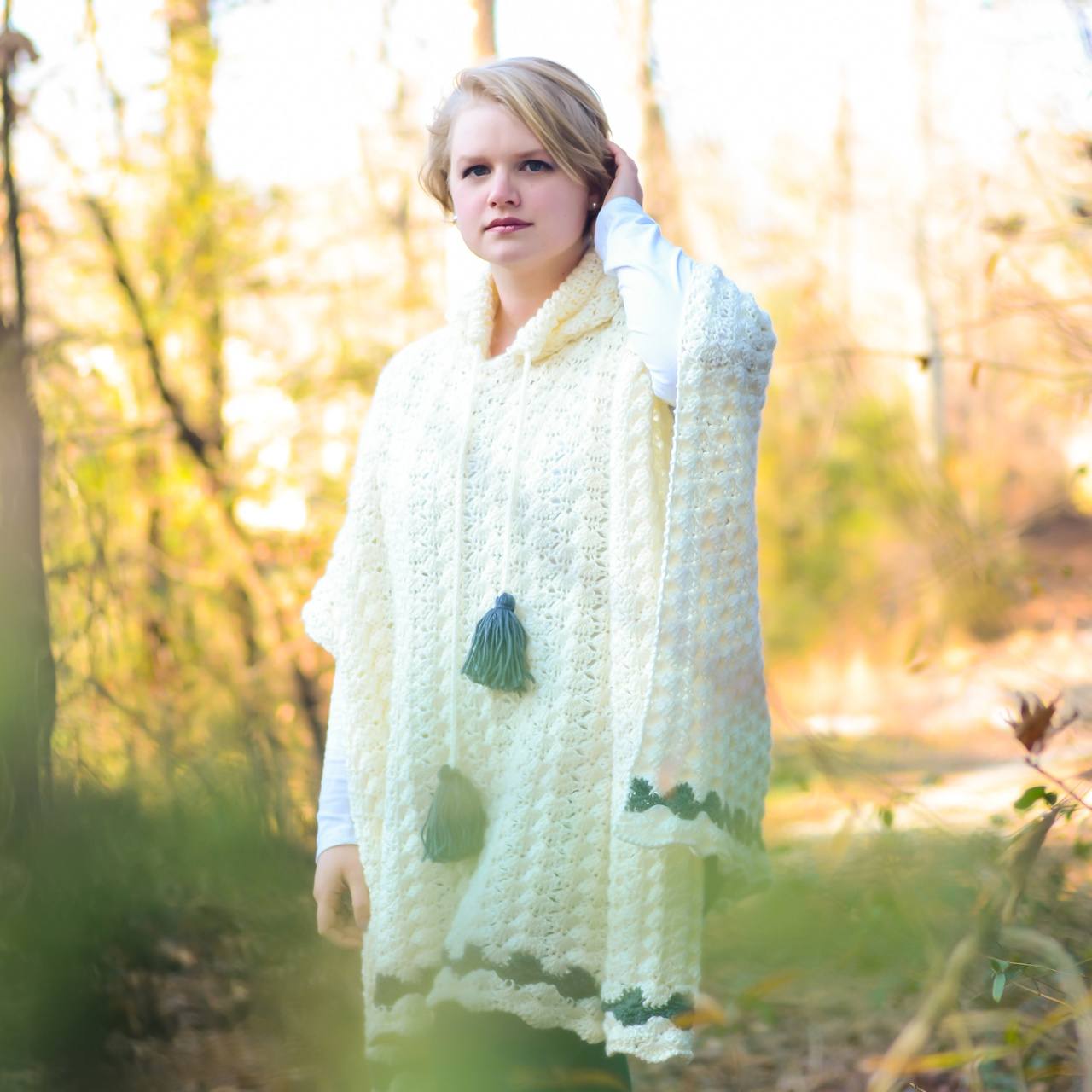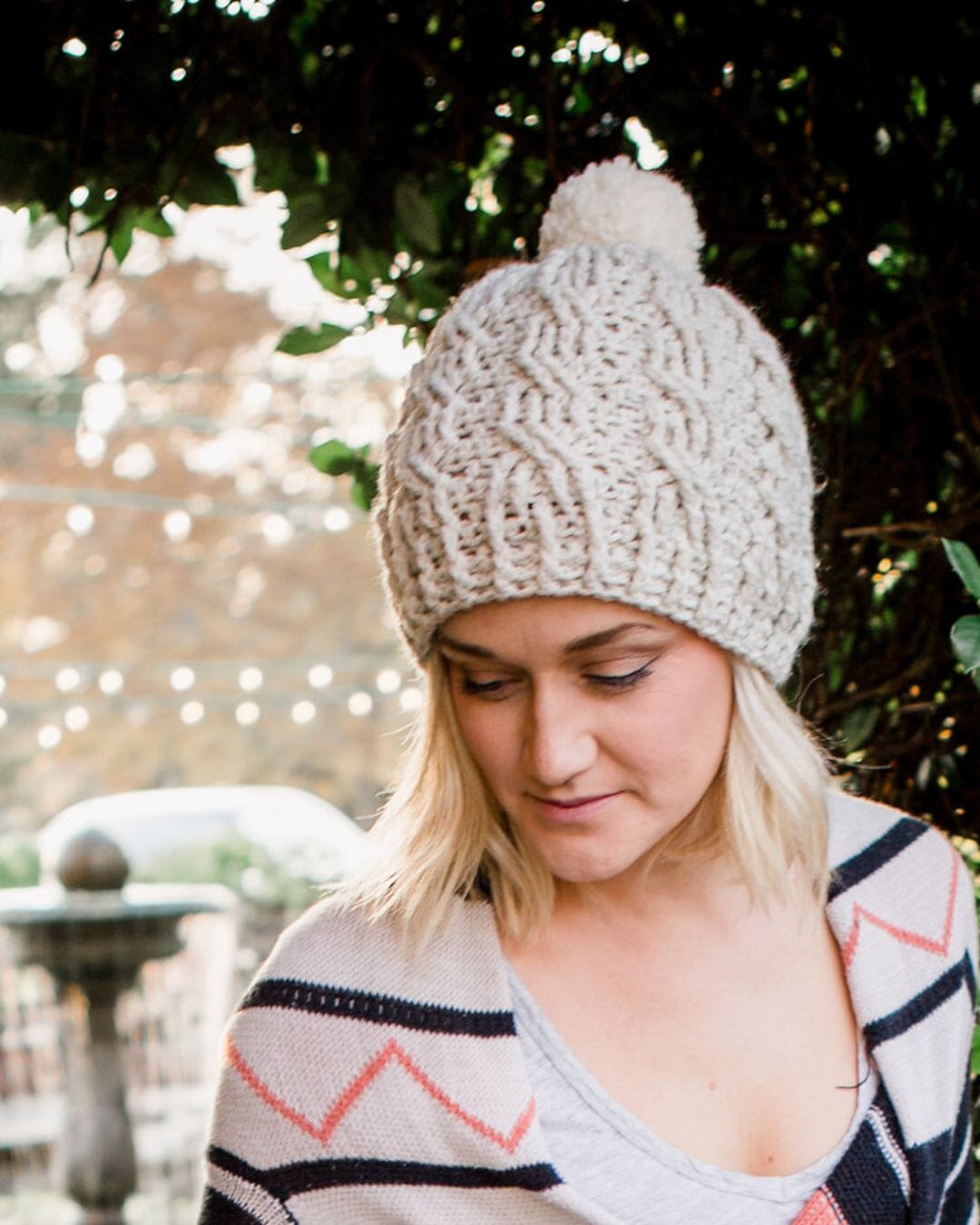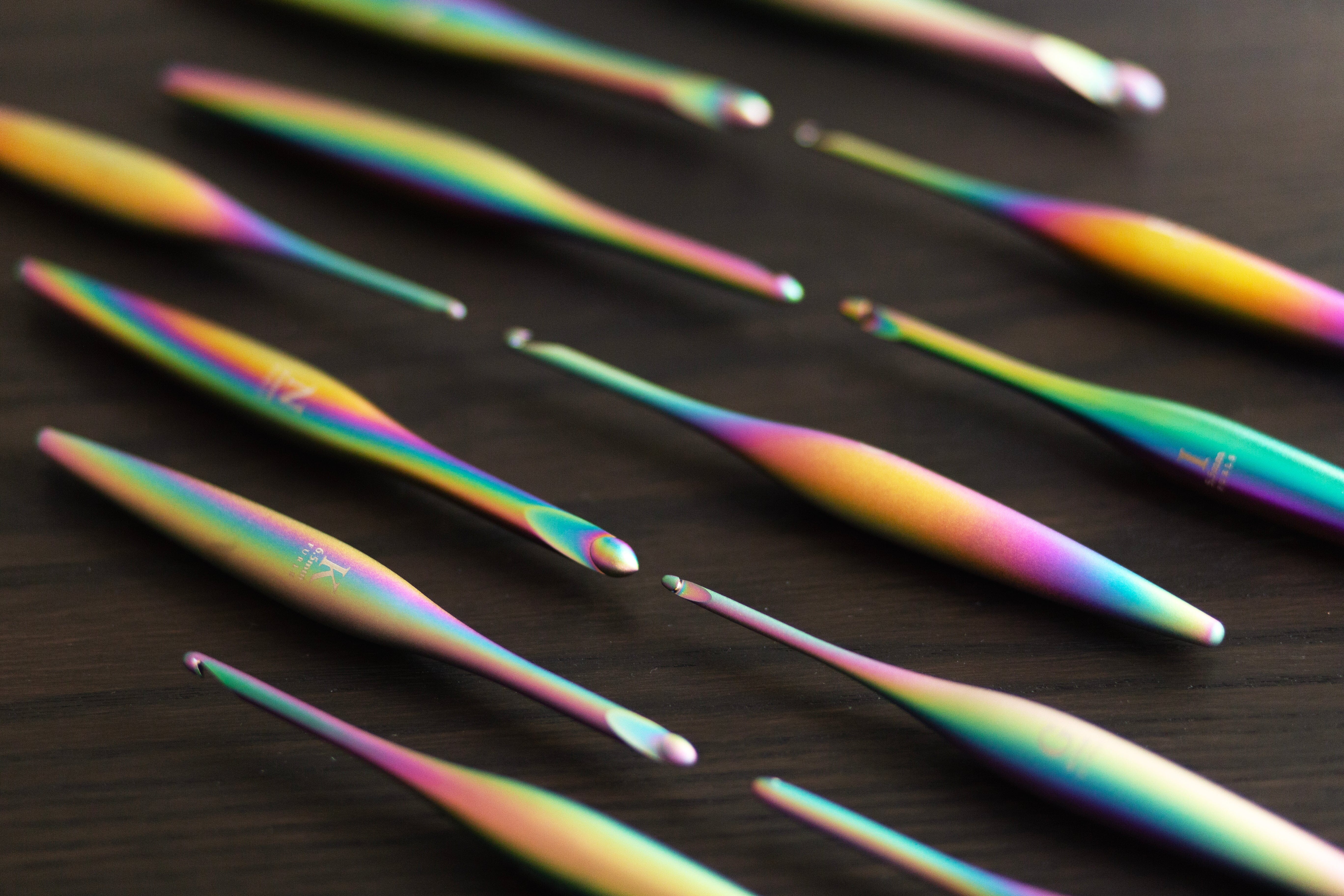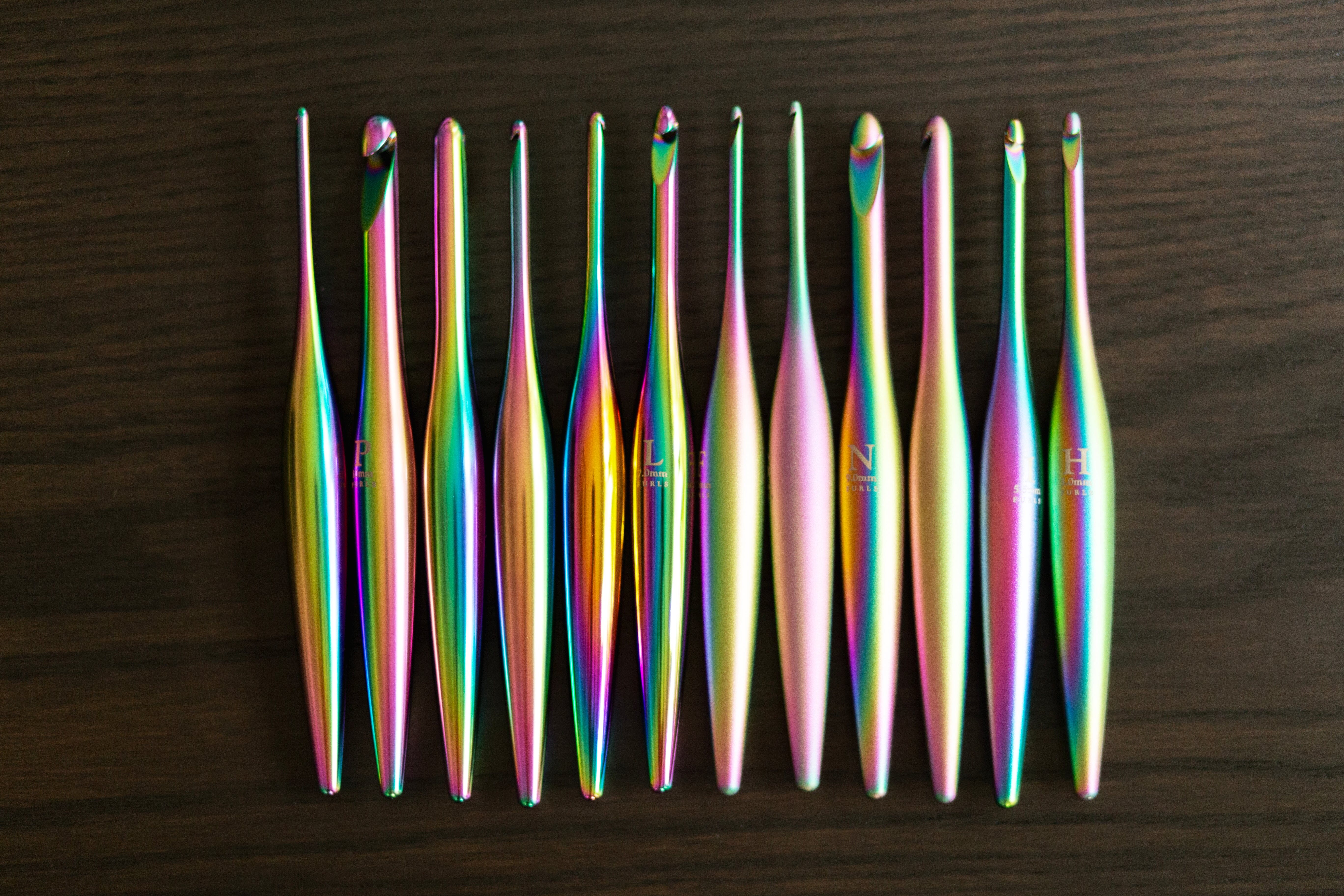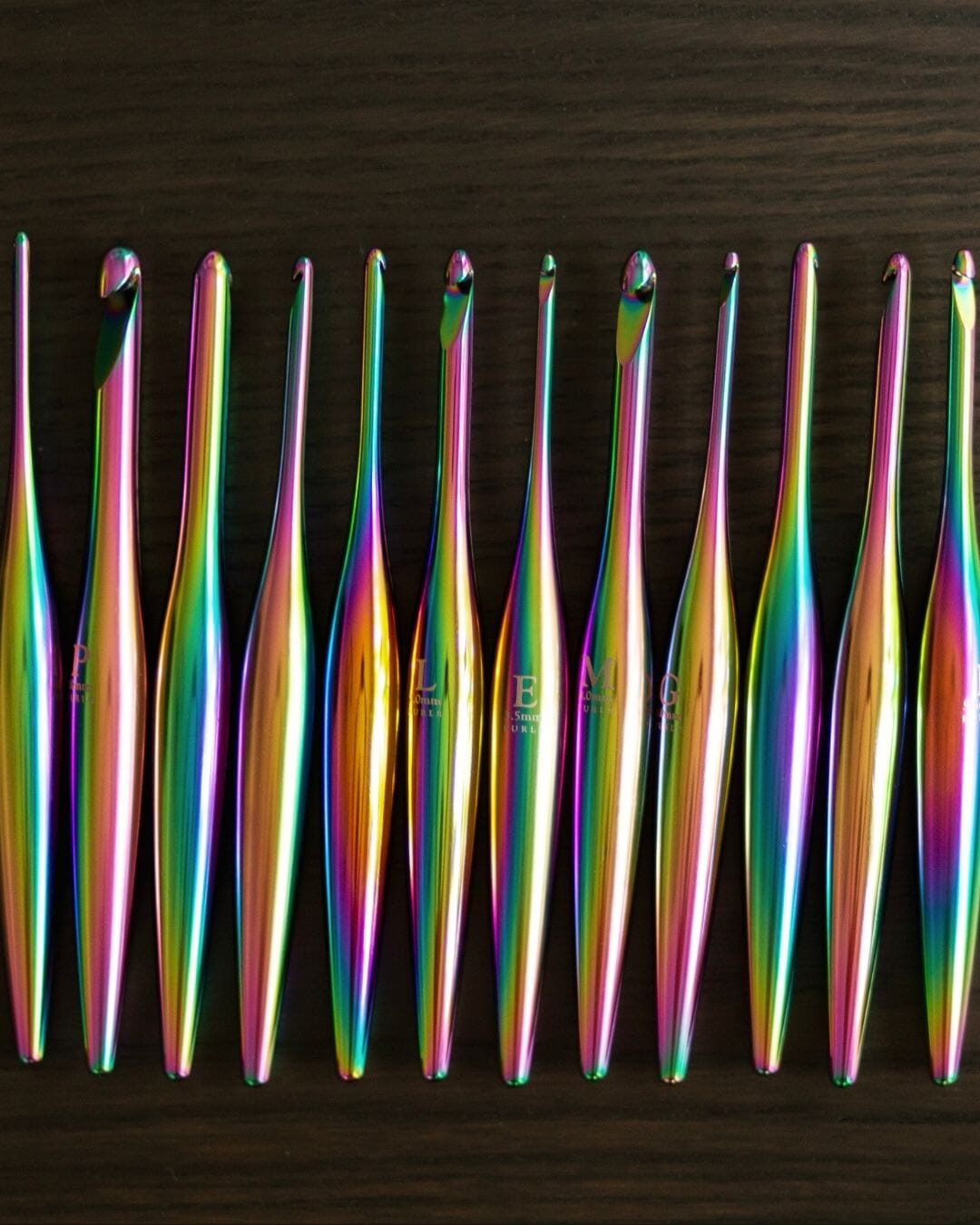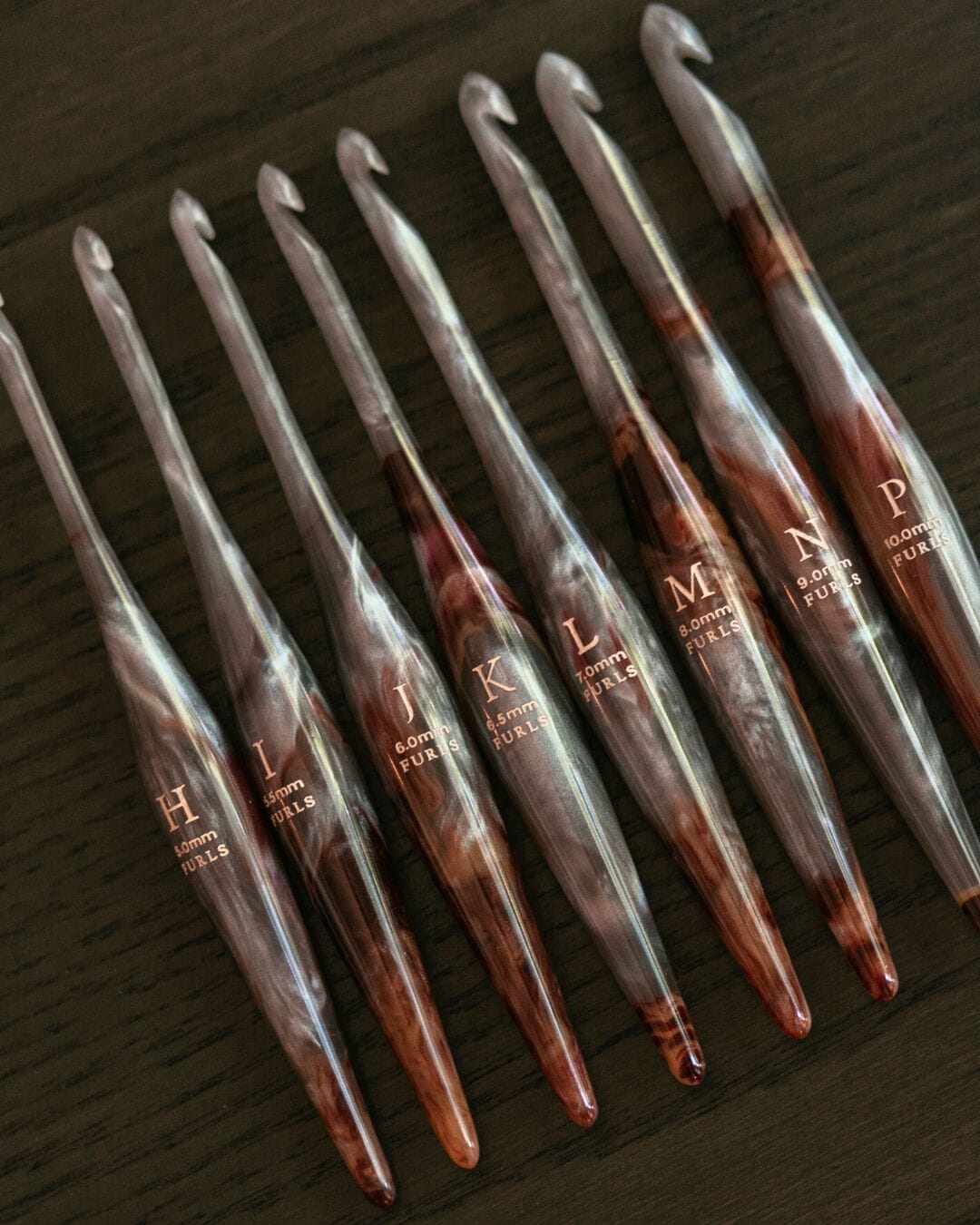Welcome to the Polcinigo Poncho CAL hosted by Furls Crochet! The Polcinigo Poncho pattern is inspired by the memory of history. Growing up in a small village in Italy, we often rode our bikes to the neighboring village to explore the palace ruins perched on a hill near the center of town. I imagined stepping back through time as I walked through the crumbling architecture. The roof had long since fallen and the floor had been replaced with a carpet of grass and weeds, but that palace seemed to be the home of so many secrets and adventures. I loved finding the bits of painted plaster that had fallen from the forsaken walls; chills chased down my spine as I raced from room to room, imaging the dramas that had unfolded centuries ago.

The Polcinigo Poncho pattern is made in four pieces and assembled at the end. In week one, we will create the front panel and back panels. This pattern features a unique shell stitch that cascades from the top down, mimicking the intricate patterns painted on the plaster of Polcinigo Palace. Toward the bottom of the poncho, the shell stitch perfectly integrates with the Catherine’s Wheel stitch, imitating the intricately painted borders along the ceilings of the palace. The panel is finished off with the reverse single crochet stitch around the three edges that will not be seamed later. The reverse single crochet gives a beautiful finished look to the poncho.
In week two, we will create the hood, the hood ribbing, the i-cord drawstring, and the tassels.
In week three, we will assemble the pieces and show off our creations!

ABOUT OUR DESIGNER
Hi! My name is Rebekah Haas. I am the wife of a teacher and the mother of four humans, two dogs, and probably fifty plants. In my free time (cue the mindless laughter of one who doesn’t sleep much), I strive to create beauty and inspire others to do the same. I learned to crochet from my mother, who learned from her mother. I’m honored to carry on a legacy of creativity! I’ve played around with my craft for almost twenty years before I started designing my own patterns. After spending my childhood living in Italy and traveling to the surrounding nations, I love to tell stories through my patterns. Each one is inspired by the sights, sounds, smells, and even the taste of travel! Each pattern blog post begins with the story of my inspiration, whether that be the smell of spices in an outdoor market, or the laughter of my own children in my backyard. I invite you to travel with me through my patterns and share in my joy as we crochet together!
Follow Rebekah
Blog | Instagram | Facebook | Ravelry | YouTube
SUPPLIES
Worsted weight (4) yarn
MC: We Crochet Mighty Stitch Cream 11 skeins (208 yds/100 grams per skein)
CC: We Crochet Mighty Stitch Ash 1 skein (208 yds/100 grams per skein)
US K-10.5 / 6.5 mm crochet hook

PATTERN DETAILS
Abbreviations (U.S. Terms)
MC - Main color
CC - Contrast color
Ch - Chain
BLO - Back loop only
Dc - Double crochet
Dc4tog - Double crochet 4 together
Dc7tog - Double crochet 7 together
Fsc - Foundation single crochet
Half shell - See special stitches
Sc - Single crochet
Sl St - Slip stitch
Sp - Space
St(s) - Stitch(es)
Shell - See special stitches
Rsc - Reverse single crochet
Special Stitches
Shell - Dc 7 in same st.
Half shell - Dc 4 in same st.
Dc4tog - Yarn over, pull up a loop in the indicated st, yarn over, pull through two loops, *yarn over, pull up a loop in the next st, yarn over, pull through two loops*, repeat between * * twice more, yarn over, pull through all five loops on hook.
Dc7tog - Yarn over, pull up a loop in the indicated st, yarn over, pull through two loops, *yarn over, pull up a loop in the next st, yarn over, pull through two loops*, repeat between * * five more times, yarn over pull through all eight loops on hook.

Notes
- The poncho is made in four pieces: front panel, back panel, hood, and hood ribbing.
- After all the pieces are complete, the items are blocked and then seamed together.
- Panels are worked top down.
- Optional finishing touches include the i-cord drawstring and tassels.
- The pattern is a stitch multiple of 8+1. If you want the items to be wider, you can do so by creating foundation single crochets in multiples of eight, then add one more before creating the turning chain.
- Turn at the end of each row.
- Turning chains do not count as stitches.
- Row count is listed at the end of each row.
- Stitches between *asterisks* are repeated across the row.

PART ONE
For Part One, we will make the front and back panels of the poncho. The panels feature a modified shell stitch that is worked from the top to the bottom, so the shells cascade down the garment. At the bottoms of the poncho, we will create a Catherine’s Wheel accent stripe. The panel is finished with a row of reverse single crochet around the three edges that will not be seamed to give it a professional and finished look.
The back panel will be a repeat of the front panel, but since they are large panels, they can be time consuming to make. We will follow the same steps we did for the front panel creating a panel reminiscent of the patterned plaster on the walls of the Polcinigo Palace.
Panels (make 2)
Row 1: Using MC, fsc 137.
Row 2: Ch 2, half shell in first st, sk 2 sts, sc 3, *sk 2 sts, shell, sk 2 sts, sc 3*, repeat until three sts remain, sk 2 sts, half shell in last st. (16 shells, 2 half shells, 51 sc)
Row 3: Ch 1, sc in each of first two sts, sk 3 sts, shell in center sc of sc-3 of previous row, sk 3 sts, *sc 3, sk 3 sts, shell in next st, sk 3 sts,* repeat until 2 sts remain, sc in each of last two sts. (17 shells, 52 sc)
Rows 4-51: Repeat rows 2-3.
Row 52: Using CC, ch 2, dc4tog across next four sts, ch 2, sc 3, ch 2, *dc7tog across next seven sts, ch 2, sc 3, ch 2,* repeat until four sts remain, dc4tog across last four sts. (16 dc7tog, 2 dc4tog, 51 sc)
Row 53: Ch 2, half shell in first st, sk ch-2 sp, sc 3, *sk ch-2 sp, shell in dc7tog, sk ch-2 sp, sc 3,* repeat until last dc4tog remains, half shell in last st. (16 shells, 2 half shells, 51 sc)
Row 54: Using MC, ch 1, sc in each of first two sts, sk 3 sts, shell in center sc of sc-3 of previous row, sk 3 sts, *sc 3, sk 3 sts, shell in next st, sk 3 sts,* repeat until two sts remain, sc in each of last two sts. (17 shells, 52 sc)
Row 55: Ch 2, half shell in the first st, sk 3 sts, sc 3, *sk 3 sts, shell, sk 3 sts, sc 3*, repeat until four sts remain, sk 3 sts, half shell in last st. (16 shells, 2 half shells, 51 sc)
Rows 56-57: Repeat rows 54-55. Fasten off and weave in ends.
Using MC, pick up a loop in the top right corner of the panel and rsc in each st around the sides and bottom, placing two rsc in each corner. Do NOT rsc across top of Row 1, but leave it for seaming.
PART TWO
In week two, we will make the hood, hood ribbing, i-cord drawstring, and two 4” tassels. The hood is made in much the same way as the front panels, using the modified shell stitch, but without the contrasting Catherine’s Wheel stripe we saw in weeks one and two. After finishing the main part of the hood, we will also crochet the hood ribbing, which will be folded and seamed to form a tube casing for the i-cord drawstring. If you are unfamiliar with i-cord construction, you can substitute a long row of fsc.
Hood
Row 1: Using MC, fsc 81.
Row 2: Ch 2, half shell in first st, sk 2 sts, sc 3, *sk 2 sts, shell, sk 2 sts, sc 3*, repeat until 3 sts remain, sk 2 sts, half shell in last st. (9 shells, 2 half shells, 30 sc)
Row 3: Ch 1, sc in each of first two sts, sk 3 sts, shell in center sc of sc-3 of previous row, sk 3 sts, *sc 3, sk 3 sts, shell in next st, sk 3 sts,* repeat until two sts remain, sc in each of last two sts. (10 shells, 31 sc)
Rows 4-17: Repeat rows 2-3. Fasten off, weave in ends.
Fold hood in half so that row 17 is doubled over on itself. Sl st both halves of row 17 together to form the seam at the back of the hood. The front of the hood is the fsc row where we will attach the ribbing. Turn right side out, so the seam is on the inside.
Hood Ribbing
Row 1: Using MC, fsc 10. (10 sc)
Rows 2-81: Ch 1, sc in BLO. (10 sc). Do not fasten off.
Fold the ribbing in half lengthwise and sc along the edges together to form a long tube.
I-cord drawstring:
Using MC
- Pull the yarn through the hole in the base of the lucet fork from back to front and hold it in place with your thumb.
- Wrap the yarn in front of the left tong.
- Continue wrapping the yarn back between the tongs and around the right tong.
- Continue carrying the yarn behind the right tong, between both tongs, and around the front of the left tong again (two loops on the left tong).
- Continue carrying the yarn behind the left tong, between both tongs, and around the front of the right tong.
- Pass the yarn back between the tongs and hold the yarn behind the handle of the fork using your index finger of the same hand of the thumb that is holding the tail.
- Lift the bottom loop of the left tong over the top loop, and off the tong.
- Lift the bottom loop of the right tong over the top loop, and off the tong.
- Pull tight.
- Wrap the yarn around the front of the left tong, and continue in the same manner as in steps 5 and 6. Each tong should again have two loops.

Repeat steps 7-10 until you have about 3 feet of i-cord.
To fasten off, take the left loop off and place it on the right tong, pull the bottom loop on the right tong over the top loop and off the tong. Cut the yarn and pull the end through the remaining loop. Leave the ends to attach tassels to after threading through the hood ribbing.
Tassels
Make two 4” tassels using CC.
PART THREE
In week three, we will assemble all the pieces and show off our marvelous work! First, designate a right side for each piece. If needed, mark the right side with a stitch marker to help you remember, since both sides of each piece are essentially the same. Next, we will use a sl st seam, since it is quick and easy to make and mimics a serged seam for knitted and crocheted garments. Make sure to keep your sl sts loose so the material doesn’t bunch or ripple. These finishing touches will leave ready to set off on a palace adventure of your own! Wait, what palace? Don’t remember? Go back to the first post to read how this pattern was inspired by the ruins of the Polcinigo Palace.
Seaming:
Designate a “right side” for all pieces. They should all look the same on both sides, but by designating which is the right and which is the wrong side, you can ensure that the seams will all be hidden inside the garment at the end.
Poncho:
- Place front and back panels right sides together.
- Pick up a loop in the top right corner through both panels.
- Sl st through the fsc of both panels in the next 60 sts. Fasten off and weave in ends.
- Pick up a loop in the other corner and repeat step 3.
Hood:
- Place the hood and ribbing right sides together.
- Pick up a loop in the bottom corner through the long sc edge of the ribbing and the fsc row of the hood.
- Sl st each sc from the ribbing to the fsc of the hood.
- Turn so the seam is on the inside of the hood.
- Thread the i-cord through the hood by threading the tail of the i-cord through a large yarn needle and pulling it through the ribbing tube. Attach tassels.
Hood to the Poncho:
- Pin the hood to the poncho as follows:
- With right sides together, place the portion of the hood where the ribbing and hood panel meet next to the center front of the sts left unseamed on the poncho body, and pin in place.
- Pin the back seam of the hood to the center st of the unseamed fsc of the back panel.
- Pin the front bottom corner of the hood next to the center st of the front panel.
- The two front corners of the hood should meet in the center front panel.
- You will not work into the hood ribbing.
- Starting in the front, sl st the hood to the poncho. Fasten off and weave in ends.
- Turn right side out.




